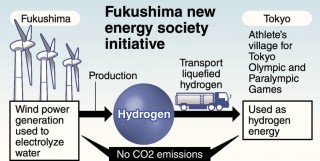Loading
Search
▼ Fukushima Set To Become Hydrogen Production Center
- Category:Other
The Yomiuri Shimbun
Prime Minister Shinzo Abe on Saturday revealed a plan to make Fukushima Prefecture a center for the development of hydrogen energy technology in Japan.
According to his plan, dubbed “Fukushima new energy society initiative,” facilities will be developed in the prefecture by 2020 to produce enough hydrogen for annual consumption by 10,000 fuel-cell cars. Electricity to provide hydrogen would be generated by renewable energy sources such as wind power. Part of the hydrogen produced will be used for the 2020
Tokyo Olympic and Paralympic Games, he said.
A public-private task force for the initiative, with the addition of the Fukushima prefectural government and electric power companies, will be established by the end of March to work on details of the plan.
Water will be electrolyzed to produce hydrogen by using 10,000 kilowatts of electricity collected from renewable energy sources such as wind power stations, according to the plan. Technology for efficient transportation of liquefied hydrogen will also be developed. The liquefied hydrogen will be used to run fuel-cell cars transporting athletes at the Tokyo Olympics and generate electricity at the Olympic village.
Hydrogen does not emit carbon dioxide (CO2) when it burns. However, CO2 is emitted in the production process because fossil fuels are currently used. If renewable energy such as wind power is used instead, it will help to reduce CO2 emissions.
“I would like to make Fukushima a major place of hydrogen production,” said the prime minister when he visited Naraha in the prefecture for inspections. Since the prefecture is a suitable region for wind power generation, the government plans to help the development of wind power stations in its coastal areas and Abukuma mountains.
If realized, the initiative will help the promotion of fuel-cell cars that run on hydrogen. Toyota Motor Corp. put Mirai, the world’s first fuel-cell car, on sale in December last year, and the government is supporting the dissemination of such cars. Development of facilities for the stable supply of hydrogen is also said to be essential for the growth strategy of Japan.
However, there were only 41 hydrogen stations open around the country as of Feb. 17. If the hydrogen supply system is improved, it is expected that it will become easier to open more hydrogen stations. At present, hydrogen is made mainly from fossil fuels such as oil. If it is produced from water using wind power and other renewable energy sources, the impact will be significant. But the method still has many problems, including those related to technology and high production costs.
Prime Minister Shinzo Abe on Saturday revealed a plan to make Fukushima Prefecture a center for the development of hydrogen energy technology in Japan.
According to his plan, dubbed “Fukushima new energy society initiative,” facilities will be developed in the prefecture by 2020 to produce enough hydrogen for annual consumption by 10,000 fuel-cell cars. Electricity to provide hydrogen would be generated by renewable energy sources such as wind power. Part of the hydrogen produced will be used for the 2020
Tokyo Olympic and Paralympic Games, he said.
A public-private task force for the initiative, with the addition of the Fukushima prefectural government and electric power companies, will be established by the end of March to work on details of the plan.
Water will be electrolyzed to produce hydrogen by using 10,000 kilowatts of electricity collected from renewable energy sources such as wind power stations, according to the plan. Technology for efficient transportation of liquefied hydrogen will also be developed. The liquefied hydrogen will be used to run fuel-cell cars transporting athletes at the Tokyo Olympics and generate electricity at the Olympic village.
Hydrogen does not emit carbon dioxide (CO2) when it burns. However, CO2 is emitted in the production process because fossil fuels are currently used. If renewable energy such as wind power is used instead, it will help to reduce CO2 emissions.
“I would like to make Fukushima a major place of hydrogen production,” said the prime minister when he visited Naraha in the prefecture for inspections. Since the prefecture is a suitable region for wind power generation, the government plans to help the development of wind power stations in its coastal areas and Abukuma mountains.
If realized, the initiative will help the promotion of fuel-cell cars that run on hydrogen. Toyota Motor Corp. put Mirai, the world’s first fuel-cell car, on sale in December last year, and the government is supporting the dissemination of such cars. Development of facilities for the stable supply of hydrogen is also said to be essential for the growth strategy of Japan.
However, there were only 41 hydrogen stations open around the country as of Feb. 17. If the hydrogen supply system is improved, it is expected that it will become easier to open more hydrogen stations. At present, hydrogen is made mainly from fossil fuels such as oil. If it is produced from water using wind power and other renewable energy sources, the impact will be significant. But the method still has many problems, including those related to technology and high production costs.
- March 7, 2016
- Comment (0)
- Trackback(0)


